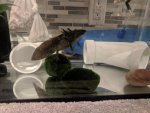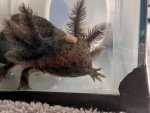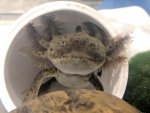mdtaylor
New member
- Joined
- Apr 24, 2018
- Messages
- 29
- Reaction score
- 1
- Points
- 0
- Location
- Pittsburgh, PA
- Country
- United States
Hi all,
So... I've made some progress in cycling my tank, but I'm a bit stuck again. Recap: I rescued a very tiny axolotl and there was no time to get a tank cycled, so unfortunately I'm doing it lotl-in. I'm incredibly attached to my little dude so I'm very particular about keeping the ammonia and nitrites down. I didn't see any nitrites at all until about a month and a half in, though I occasionally had nitrates (which I think may have just come from some of the bottle bacteria I added since they didn't seem to be coming naturally). A little under two months, ammonia started going down and nitrites went up. Now the nitrites are high and stay high, seemingly no matter how much of a water change I do. I've been in the high-nitrite phase for a little more than two weeks I think. How long does it typically take to get past the nitrite phase, and do you think doing significant daily water changes is slowing it down?
Here are some more details, in case you can solve the mystery of what I'm doing wrong... I'll attach a picture of the tank. Kimchee started at a little more than two inches and he hit 7 in about two months, so he makes more waste now, and is also hungry for pellets all the time. I never leave food in the tank and I vacuum up the poo as soon as I see it. I realize keeping him plump is probably contributing to the high nitrites, but I'm constantly testing and changing the water and I feel bad not dropping him a pellet when I'm done annoying him.
The tank is a standard 10-gallon (filled to about 6) with a sponge filter the size of a large jar of peanut butter. I've got a small airstone on the other side of the tank. There are two large moss balls and an anubias, two large rocks, a little bag of crushed coral for hardness, and two PVC pipes on a bare tank bottom.
Typical parameters are:
Temp: 63.5F
pH: 7.2
Ammonia: 0ppm
Nitrites: 2-3 ppm
Nitrates: 20ppm
GH: Pretty hard but can't remember the number (because of a little bag of crushed coral)
kH: A little less than I'd like, also forgotten the number
I'm testing everything with an API Master Test Kit along with liquid tests for GH/KH. Keeping the nitrites from exploding, I do a 1-gallon water change in the morning and a 2-gallon water change in the evening. The sponge filter always runs and I don't let the water level reach the top of the sponge during water changes. It seems to be doing a great job of holding on to the ammonia-to-nitrite bacteria. I use 0.5ml of Tetra dechlorinator (but not stress coat) when I prepare the water in a 1-gallon fishbowl, let it sit for as many hours as possible, and then also add about 0.5ml of Seachem Prime per new gallon of water (about 1.5ml per day total) because the nitrite levels seem high. I'd leave out the Tetra while using the Prime, but he seems to like whatever non-aloe slime coat stuff it has in it. (My raw tap water is very soft and doesn't test for any chlorine, BTW.)
...I feel like maybe changing a little less than half of the water per day might be slowing things down, but I'm worried about letting the nitrites get too high. Kimchee doesn't seem to mind one bit; he's active and happy and only gets grumpy if I get near the tank and don't give him a pellet. His gills are majestically frilly and long. Occasionally he'll eat a bubble from the air stone or come up for air, but I only see him do that maybe once every three days. I assume the Prime is doing its job and keeping the nitrite neutralized. Is it right that it's still edible by the bacteria when it's neutralized, or is that part of the reason none of those bacteria are really multiplying?
Nominally I know it would be best to minimize nitrite exposure, but what would people consider a panic level, assuming no visible lotl stress? Currently I panic when it goes above 2, change as much water as I can without exposing the filter to air, but the nitrite level just bounces right back up. I've verified the nitrite levels with two brands of test strips as well.
I'm so conflicted because right before the ammonia disappeared, I was about to move Kimchee to a different, smaller tank while I tried to cycle the main one, but now it feels like I must be close and I hate to stress him by moving him to a smaller home and then moving him back, especially since he seems so happy where he is.
Anyways... that's where I am. I really want his tank to get cycled and cozy, both for his sake and so that I don't end up spending several hours per day making sure that everything is as perfect as possible for him. I brought him back from death's doorstep when I got him, so I feel very attached and responsible for his well-being. He's my favorite little knob. Any advice would be greatly appreciated! Maybe I just need to stay patient and not panic so much. Thanks all!
So... I've made some progress in cycling my tank, but I'm a bit stuck again. Recap: I rescued a very tiny axolotl and there was no time to get a tank cycled, so unfortunately I'm doing it lotl-in. I'm incredibly attached to my little dude so I'm very particular about keeping the ammonia and nitrites down. I didn't see any nitrites at all until about a month and a half in, though I occasionally had nitrates (which I think may have just come from some of the bottle bacteria I added since they didn't seem to be coming naturally). A little under two months, ammonia started going down and nitrites went up. Now the nitrites are high and stay high, seemingly no matter how much of a water change I do. I've been in the high-nitrite phase for a little more than two weeks I think. How long does it typically take to get past the nitrite phase, and do you think doing significant daily water changes is slowing it down?
Here are some more details, in case you can solve the mystery of what I'm doing wrong... I'll attach a picture of the tank. Kimchee started at a little more than two inches and he hit 7 in about two months, so he makes more waste now, and is also hungry for pellets all the time. I never leave food in the tank and I vacuum up the poo as soon as I see it. I realize keeping him plump is probably contributing to the high nitrites, but I'm constantly testing and changing the water and I feel bad not dropping him a pellet when I'm done annoying him.
The tank is a standard 10-gallon (filled to about 6) with a sponge filter the size of a large jar of peanut butter. I've got a small airstone on the other side of the tank. There are two large moss balls and an anubias, two large rocks, a little bag of crushed coral for hardness, and two PVC pipes on a bare tank bottom.
Typical parameters are:
Temp: 63.5F
pH: 7.2
Ammonia: 0ppm
Nitrites: 2-3 ppm
Nitrates: 20ppm
GH: Pretty hard but can't remember the number (because of a little bag of crushed coral)
kH: A little less than I'd like, also forgotten the number
I'm testing everything with an API Master Test Kit along with liquid tests for GH/KH. Keeping the nitrites from exploding, I do a 1-gallon water change in the morning and a 2-gallon water change in the evening. The sponge filter always runs and I don't let the water level reach the top of the sponge during water changes. It seems to be doing a great job of holding on to the ammonia-to-nitrite bacteria. I use 0.5ml of Tetra dechlorinator (but not stress coat) when I prepare the water in a 1-gallon fishbowl, let it sit for as many hours as possible, and then also add about 0.5ml of Seachem Prime per new gallon of water (about 1.5ml per day total) because the nitrite levels seem high. I'd leave out the Tetra while using the Prime, but he seems to like whatever non-aloe slime coat stuff it has in it. (My raw tap water is very soft and doesn't test for any chlorine, BTW.)
...I feel like maybe changing a little less than half of the water per day might be slowing things down, but I'm worried about letting the nitrites get too high. Kimchee doesn't seem to mind one bit; he's active and happy and only gets grumpy if I get near the tank and don't give him a pellet. His gills are majestically frilly and long. Occasionally he'll eat a bubble from the air stone or come up for air, but I only see him do that maybe once every three days. I assume the Prime is doing its job and keeping the nitrite neutralized. Is it right that it's still edible by the bacteria when it's neutralized, or is that part of the reason none of those bacteria are really multiplying?
Nominally I know it would be best to minimize nitrite exposure, but what would people consider a panic level, assuming no visible lotl stress? Currently I panic when it goes above 2, change as much water as I can without exposing the filter to air, but the nitrite level just bounces right back up. I've verified the nitrite levels with two brands of test strips as well.
I'm so conflicted because right before the ammonia disappeared, I was about to move Kimchee to a different, smaller tank while I tried to cycle the main one, but now it feels like I must be close and I hate to stress him by moving him to a smaller home and then moving him back, especially since he seems so happy where he is.
Anyways... that's where I am. I really want his tank to get cycled and cozy, both for his sake and so that I don't end up spending several hours per day making sure that everything is as perfect as possible for him. I brought him back from death's doorstep when I got him, so I feel very attached and responsible for his well-being. He's my favorite little knob. Any advice would be greatly appreciated! Maybe I just need to stay patient and not panic so much. Thanks all!



